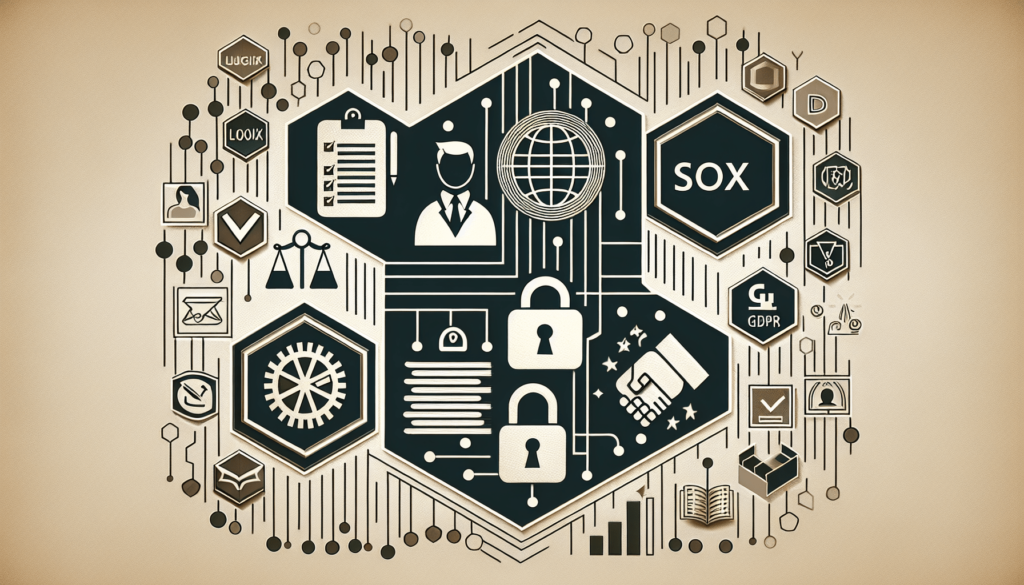In today’s business environment, adhering to compliance regulations is of utmost importance. Compliance audits serve as a crucial tool for evaluating an organization’s adherence to these standards and mitigating risks. However, with the myriad of compliance audit standards available, it can be overwhelming to determine which ones are the most popular and should be followed. In this article, we will explore the most widely recognized compliance audit standards that businesses should consider implementing, ensuring their operations remain in line with industry best practices and legal requirements. By adhering to these standards, organizations not only protect their reputation but also safeguard their stakeholders’ interests.

ISO 9001
Overview of ISO 9001
ISO 9001 is an internationally recognized standard that provides a framework for implementing a Quality Management System (QMS). This standard sets out the criteria for a QMS and is based on a number of quality management principles, including a strong customer focus, involvement of top management, and a process approach. ISO 9001 provides organizations with a systematic and structured approach to managing quality, enabling them to consistently meet customer requirements and enhance customer satisfaction.
Importance of ISO 9001 in Compliance Audits
ISO 9001 plays a crucial role in compliance audits as it provides a benchmark for evaluating an organization’s ability to meet customer needs and regulatory requirements. Compliance audits assess whether an organization is operating in accordance with applicable standards, regulations, and industry best practices. By implementing ISO 9001, organizations can demonstrate their commitment to quality management and improve their chances of passing compliance audits. ISO 9001 certification serves as evidence of an organization’s compliance with industry standards and enhances its reputation in the marketplace.
Key Requirements and Elements of ISO 9001
ISO 9001 consists of several key requirements and elements that organizations must adhere to in order to achieve certification. These include:
-
Quality Policy: Organizations must establish a quality policy that reflects their commitment to meeting customer requirements and continuously improving their products and services.
-
Quality Objectives: Organizations must define measurable quality objectives that align with their overall business goals and continuously monitor their performance against these objectives.
-
Documented Information: ISO 9001 requires the establishment and maintenance of documented information, including quality manuals, policies, procedures, and records.
-
Risk-Based Thinking: Organizations must adopt a systematic approach to identify and manage risks and opportunities that could affect their ability to meet customer requirements and enhance customer satisfaction.
-
Continual Improvement: ISO 9001 emphasizes the importance of continual improvement by encouraging organizations to identify and implement actions to enhance their performance and customer satisfaction.
Benefits of Implementing ISO 9001
Implementing ISO 9001 can provide numerous benefits to organizations, including:
-
Enhanced Customer Satisfaction: By implementing ISO 9001, organizations can improve the quality of their products and services, leading to increased customer satisfaction and loyalty.
-
Improved Operational Efficiency: ISO 9001 promotes the use of well-defined processes and procedures, which can enhance operational efficiency, reduce errors, and minimize rework.
-
Increased Market Opportunities: ISO 9001 certification is often a requirement for participating in government tenders and other business opportunities. By obtaining certification, organizations can access new markets and attract potential customers.
-
Better Supplier Relationships: ISO 9001 emphasizes the importance of working with reliable suppliers. By implementing the standard, organizations can establish stronger relationships with their suppliers, ensuring the consistent delivery of high-quality materials and services.
-
Regulatory Compliance: ISO 9001 helps organizations meet regulatory requirements, reducing the risk of non-compliance and potential penalties.
In conclusion, ISO 9001 is a vital standard for organizations seeking to enhance their quality management practices, meet customer needs, and pass compliance audits. By implementing ISO 9001, organizations can improve their reputation, increase customer satisfaction, and gain a competitive edge in the marketplace.
ISO 27001
Introduction to ISO 27001
ISO 27001 is an international standard that sets out the requirements for establishing, implementing, maintaining, and continually improving an information security management system (ISMS) within an organization. This standard provides a systematic approach to managing sensitive information and protecting it from unauthorized access, disclosure, alteration, or destruction.
Significance of ISO 27001 in Compliance Audits
ISO 27001 plays a crucial role in compliance audits as it ensures that an organization has implemented appropriate controls to protect its information assets and comply with relevant laws, regulations, and industry standards. Compliance audits assess an organization’s adherence to specific security requirements and evaluate the effectiveness of its information security controls. By obtaining ISO 27001 certification, organizations can demonstrate their commitment to information security and improve their chances of passing compliance audits.
Critical Components of ISO 27001
ISO 27001 consists of several critical components that organizations must address to achieve certification. These components include:
-
Risk Assessment: ISO 27001 requires organizations to systematically identify and assess information security risks to determine the necessary controls and mitigation strategies.
-
Information Security Policy: Organizations must establish and maintain an information security policy that sets out the organization’s objectives, commitments, and framework for managing information security.
-
Asset Management: ISO 27001 emphasizes the importance of identifying and managing information assets, including their classification, ownership, and protection requirements.
-
Access Control: Organizations must implement controls to ensure that only authorized individuals have access to information assets and that their access is consistent with their roles and responsibilities.
-
Incident Management: ISO 27001 requires organizations to establish an incident management process to detect, respond to, and recover from security incidents.
Advantages of Adopting ISO 27001 Standards
Adopting ISO 27001 standards can provide several advantages to organizations, including:
-
Enhanced Information Security: ISO 27001 helps organizations protect their sensitive information assets and reduce the risk of data breaches and cyber-attacks. This enhances the confidentiality, integrity, and availability of information.
-
Regulatory Compliance: ISO 27001 helps organizations meet regulatory requirements related to information security, such as the European Union’s General Data Protection Regulation (GDPR) and industry-specific standards.
-
Competitive Advantage: ISO 27001 certification can differentiate organizations from their competitors by demonstrating their commitment to information security and bolstering customer confidence.
-
Improved Business Continuity: ISO 27001 includes requirements for business continuity planning, ensuring that organizations can maintain critical operations and recover from disruptive incidents effectively.
-
Trusted Relationships: ISO 27001 certification can build trust with customers, partners, and stakeholders who value information security. It provides assurance that the organization has implemented appropriate controls to protect their information.
To summarize, ISO 27001 is a pivotal standard in ensuring the security of an organization’s information assets. By adhering to ISO 27001 requirements, organizations can protect sensitive information, comply with relevant regulations, and gain a competitive advantage in the marketplace.

PCI DSS
Understanding PCI DSS
The Payment Card Industry Data Security Standard (PCI DSS) is a set of security standards designed to protect cardholder data and reduce the risk of credit card fraud. It applies to all organizations that process, store, or transmit cardholder data, and is enforced by the major credit card companies.
Relevance of PCI DSS in Compliance Audits
PCI DSS is highly relevant in compliance audits, especially for organizations handling credit card transactions. Compliance audits evaluate an organization’s adherence to the PCI DSS requirements, ensuring that appropriate security controls are in place to protect cardholder data. Failing to comply with PCI DSS can result in financial penalties, loss of customer trust, and reputational damage.
Essential Aspects of PCI DSS
PCI DSS comprises several essential aspects that organizations must address to achieve compliance. These aspects include:
-
Build and Maintain a Secure Network: Organizations must implement and maintain a secure network infrastructure, including firewalls, network segmentation, and secure configurations.
-
Protect Cardholder Data: PCI DSS requires organizations to implement strong data security measures, including encryption, access controls, and regular testing of security systems.
-
Maintain a Vulnerability Management Program: Organizations must regularly scan for vulnerabilities, apply security patches, and ensure that systems are protected against known threats.
-
Implement Strong Access Controls: PCI DSS emphasizes the importance of restricting access to cardholder data to authorized individuals only and assigning unique credentials to each user.
-
Regularly Monitor and Test Networks: Organizations must conduct regular monitoring and testing of their networks and systems to detect and respond to security breaches quickly.
Benefits of Compliance with PCI DSS Guidelines
Compliance with PCI DSS guidelines offers several benefits to organizations, including:
-
Enhanced Security: By complying with PCI DSS, organizations can implement robust security controls and significantly reduce the risk of data breaches and payment card fraud.
-
Reduced Liability: Compliance with PCI DSS can reduce an organization’s liability in the event of a security breach, as it demonstrates their commitment to protecting cardholder data.
-
Increased Customer Trust: Compliance with PCI DSS boosts customer confidence and trust in an organization’s ability to safeguard their sensitive payment card information.
-
Prevention of Financial Penalties: Breaching PCI DSS requirements can result in significant financial penalties and increased costs, which can be avoided through compliance.
-
Protection of Reputation: Complying with PCI DSS safeguards an organization’s reputation by demonstrating a commitment to data security and protecting customer information.
In summary, PCI DSS is a crucial standard for organizations involved in credit card processing. Compliance with PCI DSS requirements enhances data security, reduces the risk of fraud, and safeguards an organization’s reputation and customer trust.



